How Much Caffeine is in Earl Grey Tea? Master the Perfect Cup
Ever done a quick Google search to find out, "How much caffeine is in Earl Grey tea?" If so, then you're not alone. I found myself doing a similar search recently, curious to know if my favorite morning brew was responsible for those mid-day energy crashes. You see, I'm a self-proclaimed tea enthusiast and Earl Grey has always been my go-to morning brew choice. Nonetheless, I felt it was high time to understand just how much caffeine I was consuming every day through my favorite steaming cup.
Diving deeper into my quest for knowledge, I came across fascinating tidbits about Earl Grey that made me appreciate it even more. With its rich history, its unique blend of ingredients, its myriad health benefits, and its caffeine content - Earl Grey is a beautiful, complex universe packed into a cup! So, I couldn’t keep all this knowledge to myself, could I? Hence, I decided to share what I learned about the caffeine content in Earl Grey tea and other interesting facts about this esteemed brew. Shall we get started?
Also Read: Best Teas To Drink In The Morning
Article Includes
How Much Caffeine is in Earl Grey Tea?
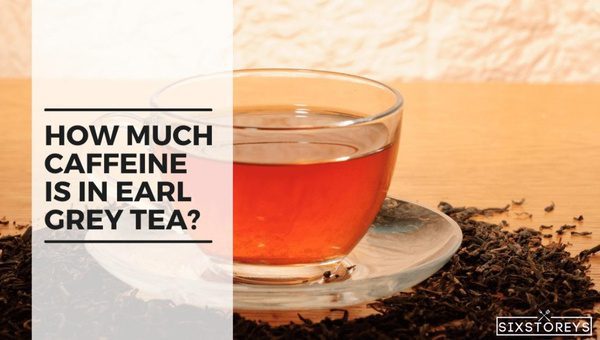
An 8-ounce cup of Earl Grey tea typically contains about 40-75 milligrams of caffeine. This caffeine level can vary depending on several factors. Earl Grey is a popular type of black tea, and black tea leaves, which are commonly used in Earl Grey, generally have a higher caffeine content compared to other tea varieties such as green or white tea.
The brewing process also plays a significant role in determining the caffeine content. The longer and hotter you brew the tea, the more caffeine is extracted. Therefore, a quick, hot brew will have less caffeine than a tea steeped for a longer period at a higher temperature.
Another aspect to consider is the role of bergamot oil in Earl Grey tea. Bergamot oil is what gives Earl Grey its distinctive citrusy flavor. However, it does not contribute to the caffeine content of the tea. Its role is purely for flavoring.
The range of caffeine content in Earl Grey, from 40-75 milligrams per 8-ounce cup, is also influenced by the specific brand and the blend of the tea. This is less than the caffeine content in an equivalent amount of coffee, which is typically around 95 milligrams.
Understanding the caffeine content in Earl Grey tea is about more than just knowing its ingredients. It involves an appreciation of the entire process, from the selection of black tea leaves to the infusion of bergamot oil. The right brewing time and the perfect blend of ingredients can significantly alter your Earl Grey tea experience, affecting both its flavor and caffeine level.
Every cup of Earl Grey tea is not just a beverage but a rich tapestry of sensory experiences, offering a world of flavor, texture, aroma, and, of course, caffeine, for the tea enthusiast to explore and enjoy.
Caffeine Consumption: Potential Side Effects
First, let's talk about caffeine. It's important to understand that caffeine, while a widely accepted part of many of our daily lives, can indeed carry some potential side effects.
Caffeine in the Body
Caffeine, a natural stimulant, works by interacting with our central nervous system. It keeps us alert, boosts our mood, and even aids in producing adrenaline. However, an excessive intake of caffeine can disturb our body's natural balance and lead to various physical and mental discomforts.
Potential Physical Side Effects
The immediate physical side effects from consuming too much caffeine can include restlessness, increased heart rate, and stomach discomfort. Persistent over-consumption can even lead to more serious complications such as chronic insomnia, digestive issues, muscle breakdown, and high blood pressure.
Psychological Repercussions
On the psychological side too, caffeine can wreak havoc if consumed indiscreetly. It can cause anxiety, agitation, restlessness, and affect your concentration. In some people, it can lead to mood swings, depression, and even an increased risk of mental health disorders.
Caffeine Withdrawal
Moreover, habitual caffeine consumers may experience withdrawal symptoms when reducing their intake. These can range from a simple headache and irritability, to fatigue, and constipation.
While caffeine in moderation can have positive effects, overconsumption can lead to unpleasant and potentially risky side effects. It's therefore necessary to monitor and regulate our caffeine intake, whether it comes from a cup of Earl Grey, a shot of espresso, or a can of soda.
Unexpected Perks: Health Benefits of Earl Grey Tea
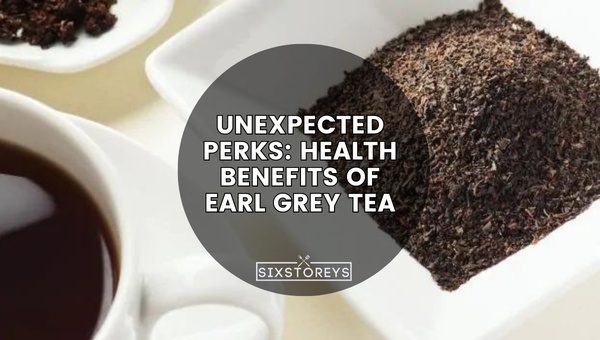
Now that we've clarified some potential concerns, let's switch gears and highlight the many health benefits that come along with a cup of Earl Grey Tea.
1. Loaded with Antioxidants
Earl Grey tea - a blend of black teas with a dash of bergamot oil - is a treasure trove of antioxidants, notably theaflavins and thearubigins. These bioactive compounds, present in abundant quantities, are known to safeguard our body against oxidative stress and play a crucial role in preventing chronic diseases.
2. Supports Heart Health
Research suggests that the regular consumption of black tea (such as Earl Grey) may lead to improvements in cholesterol levels, blood pressure, and blood sugar levels. All of these factors contribute to a healthier, stronger heart and a lower risk of developing cardiovascular diseases.
3. Digestion Booster
For centuries, people have turned to Earl Grey tea as a solution for digestion-related ailments. It aids in relieving constipation, acid reflux and fights against intestinal infections. In essence, it helps maintain an efficient and healthy digestive system.
4. Energy Enhancer
A cup of Earl Grey gives you that gentle caffeine kick, keeping lethargy at bay. While it contains less caffeine than a typical cup of coffee, it offers a perfect balance, ensuring an energy boost without the potential side effects of excessive caffeine consumption.
5. Weight Management Ally
Earl Grey's distinct ingredient - bergamot oil, is rich in a certain type of flavonoid called 'naringin'. This compound has been found useful in regulating metabolism and assisting in weight loss.
6. Oral Health Promoter
Lastly, Earl Grey tea contains high levels of catechins, an antioxidant famously known for fighting oral infections. So it's not just your taste buds Earl Grey pleases but your teeth too.
In essence, Earl Grey tea - when consumed in moderation - offers a range of health benefits from head to toe, making it an excellent choice for your daily brew. It's just one more reason for us to reach for that comforting cup of Earl Grey.
Remember, while caffeine can indeed have side effects, in moderate amounts, it can be part of a healthy lifestyle. And with the unexpected health benefits of Earl Grey tea, you're not just getting a caffeine lift, but also a health-promoting elixir! Drink responsibly and enjoy the many delights of Earl Grey.
From Leaves to Cup: How to Brew Earl Grey Tea?
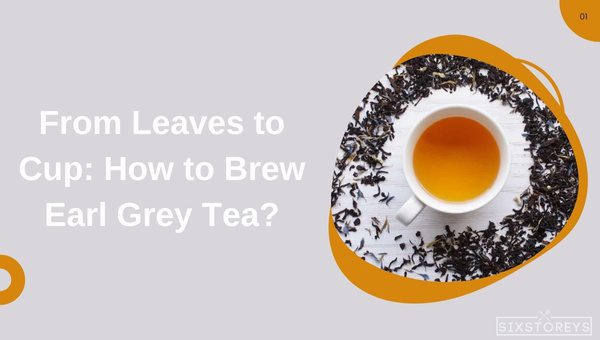
So, how do you brew Earl Grey Tea? It's simpler than you might think. With the right steps and a bit of patience, you can concoct a cup that rivals those served in fancy tea houses. Let's embark on this tea journey from leaves to cups!
Understanding Your Ingredients
Firstly, ensure that you have high-quality Earl Grey tea. This type of tea is a blend of black tea infused with the distinct flavor of bergamot, a citrus fruit. The quality of the leaves and the ratio of bergamot can vary, so taste a few varieties to choose your favorite.
The Brewing Process
To start, boil fresh, preferably filtered, water. But remember, when it comes to Earl Grey, you shouldn't use fully boiled water. Ideal temperatures should linger around 208°F (98°C), just below boiling. Overheating can result in a bitter flavor.
Now, it's time for the tea leaves. If you're using loose leaf Earl Grey, a general rule of thumb is a teaspoon (about 2 grams) for each cup. Place them into a tea infuser or teapot.
Pour the hot water on top of the tea leaves and steep for 3 to 5 minutes. The longer you let it steep, the stronger your tea will taste. However, be wary of excessive steeping, as it can draw out the bitterness.
Once your tea has reached your desired flavor, remove the tea leaves. Your Earl Grey is ready! You can enjoy it neat, or add milk, honey, or lemon to taste. Remember, if you choose to add milk, cool the tea a little first to prevent the milk from scalding.
Culinary Adventure: Experiencing Earl Grey's Taste
What does Earl Grey tea taste like? I'd describe it as a unique interplay between hearty, slightly sweet black tea and the citrusy, aromatic flair of bergamot. But let's take a deeper look at the Earl Grey tasting experience.
Aroma and Flavor Profile
The first thing to notice as you bring the cup closer is the aroma. Earl Grey has a bright, crisp scent, punctuated by the uplifting citrus note of bergamot. It's an inviting smell that has a comforting element to it.
As for the flavor, the robust base of black tea provides notes of malt and sweetness, balancing beautifully with the distinctly fragrant bergamot. The result is a rich and balanced taste, with a slight astringency and generally smooth finish.
The Earl Grey Mouthfeel
Mouthfeel is a crucial factor in the overall tasting experience. A well-brewed cup of Earl Grey has a medium body - it's not as light on the tongue as green tea nor as full-bodied as a strong black tea. There's a slight creaminess to a good Earl Grey, making it very refreshing.
Paring Your Earl Grey
When it comes to food pairings, the bold, fruity notes of Earl Grey complement sweet pastries, dark chocolate, and even some savory meals like egg-based entrees or pasta. Having your Earl Grey with some scones is a classic English choice!
While Earl Grey has a distinctive flavor, tea brands can have different flavor intensities. Some brands offer a lighter touch of bergamot in case you don't want something overpowering.
Remember the joy of tasting tea or any food product lies in the variety. So, even if your first Earl Grey doesn't jolt your palate, try a few more. Just like me, you might find your perfect blend!
Beyond the Teacup: Earl Grey Tea Recipes
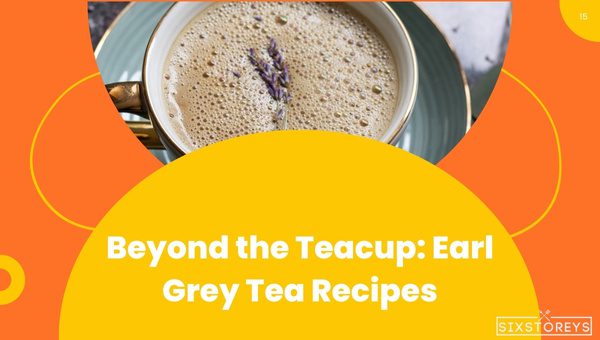
I bet you're unaware of the fantastic culinary versatility of Earl Grey tea. Many chefs and home cooks have started to think beyond the teacup and explore Earl Grey tea to infuse unique, citrusy depth of flavor to both sweet and savory dishes. Let's dig into some delicious and innovative Earl Grey Tea recipes that'll take your culinary journey to an entirely new level.
1. Earl Grey Tea-infused Cocktails
If you're an enthusiast of fancy tea-infused cocktails, consider substituting your plain spirit with an Earl Grey-infused one. This adds an earthy, citrusy note to your usual cocktail, imparting a delicate balance of sweet, sour, and bitter. Steep Earl Grey tea bags in your choice of liquor for a couple of hours or even overnight, and voila, your Earl Grey-infused spirit is ready for use!
2. Earl Grey Chocolate Truffles
Imagine the mouthfeel of decadent dark chocolate coupled with the tangy, citrusy note of Earl Grey - heavenly, right? Earl Grey chocolate truffles are easy to make and highly addictive. You simply steep Earl Grey tea in a heated concoction of cream and sugar, strain the mixture, and add it to melted dark chocolate. Once cooled and portioned, you can finish them off with a dusting of cocoa powder.
3. Earl Grey Lemon Curd
The classic English lemon curd gets a bold, aromatic upgrade with the addition of finely ground Earl Grey tea leaves. The citrusy, floral Bergamot in the tea compliments the tartness of the lemons perfectly. Spread this Earl Grey lemon curd on your morning toast, and you'll never go back to marmalade or jam!
By infusing eary flavors into cocktails, desserts, curds, and even main dishes, Earl Grey has indeed transcended the confines of the teacup.
Also Read: Best Trader Joe's Teas
Comparing Buzz Levels: Earl Grey Caffeine vs Coffee
I bet at some point, the age-old debate 'tea vs coffee' has crossed your thoughts – at least when it comes to the caffeine fix these two universally cherished beverages give. In comparing Earl Grey tea and coffee, it’s essential that we demystify their caffeine content first.
Caffeine in Earl Grey Tea
You'll be surprised to learn that an 8-ounce cup of Earl Grey tea typically contains about 20 to 45mg of caffeine. Yes, your favorite brew does help you shake off your morning grogginess! The caffeine thing about Earl Grey, however, lies in its ability to provide a mellow buzz, as opposed to coffee's more robust stimulation.
Caffeine in Coffee
Coffee is the go-to wake-up call for many, thanks to its notably high caffeine content. An 8-ounce cup of coffee can contain anywhere from 95 to 200mg of caffeine—almost four times as much as in Earl Grey tea.
The caffeine content in these two beverages is influenced by multiple factors. For instance, the tea leaves age and how long they're steeped will impact Earl Grey's caffeine. Similarly, the type of coffee bean, roast level, and brewing time play a role in a cup's caffeine strength.
Varieties of Earl Grey: Caffeine Content Across the Board
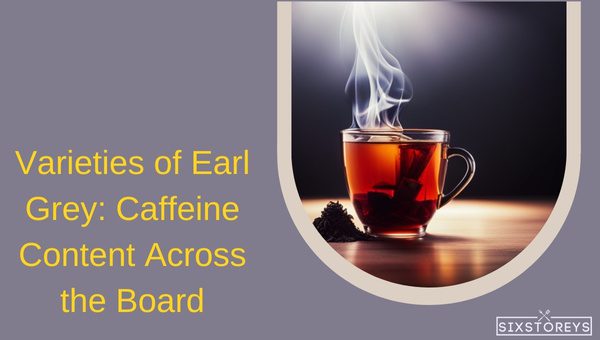
Ever wondered if all Earl Grey teas are caffeinated? Or does one variety have more caffeine than the other? As a matter of fact, the caffeine content varies across different variants of Earl Grey.
Classic Earl Grey Tea
Contrary to popular belief, traditional Earl Grey isn't as caffeinated as many think. Containing roughly 20-45mg of caffeine per 8-ounce cup, the buzz from this variant is more muted and subtle.
Decaffeinated Earl Grey Tea
For those who enjoy the distinct flavor of Earl Grey but prefer to nix the caffeine, decaffeinated versions are available. It's important to note, though, that decaffeinated doesn't mean completely caffeine-free. A cup of decaf Earl Grey still holds around 2-5mg of caffeine.
Earl Grey Green Tea
Many people love the fusion of green tea's grassy notes with tart bergamot. An 8-ounce cup of this variant generally contains 20-30mg of caffeine, making it a lighter caffeine choice.
Lady Grey Tea
A much softer and fruitier version of Earl Grey, Lady Grey Tea is often chosen by those who find classic Earl Grey too strong in flavor. The caffeine content is similar to the classic version, containing around 20-45mg per serving.
The caffeine content across the board may vary slightly, but the ultimate choice usually comes down to personal preference and tolerance.
It's Possible: Dealing with Decaffeinated Earl Grey Tea
Ever asked yourself, can Earl Grey tea be caffeine-free? Well, the answer is a reassuring yes! You can still enjoy the luxuriance of Earl Grey without the jitters of caffeine.
Decaf Earl Grey: How It’s Done
The process of decaffeination removes most of the caffeine from the tea leaves. The common methods used entail the use of solvents, carbon dioxide, or water to extract caffeine from the leaves. The essential flavor compounds are then reintroduced to the decaffeinated leaves.
It's worth mentioning that decaf doesn't mean caffeine-free. According to FDA guidelines, decaffeinated teas still contain around 2-3% of their original caffeine content. However, this residual amount is typically so low that it doesn't significantly impact the body's caffeine levels.
Taste and Experience of Decaffeinated Earl Grey
Decaf Earl Grey may sound like a dream come true for caffeine-sensitive individuals. But one key concern arises—does it still hold the same majestic flavor as the caffeinated version? Decaffeination processes can potentially affect the tea's taste, leading to a milder flavor than traditional Earl Grey. But many high-quality brands manage to maintain much of the distinctive citrusy taste we all love so much about Earl Grey.
Zesty Delight: Brewing Zest Tea Earl Grey
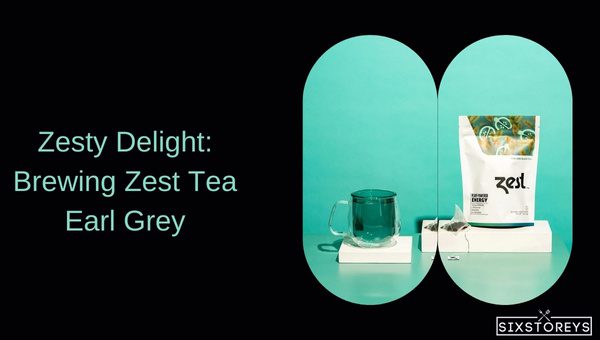
Zest Tea Earl Grey stands out as a robust, high-energy blend that packs more caffeine than your standard Earl Grey. Here's an in-depth look at this energetic brew.
Zest Tea Earl Grey: A Distinct Blend
Zest Tea's take on Earl Grey blends premium black tea with the robust, tangy notes of natural citrus flavors. What sets Zest Tea Earl Grey apart, though, is the extra caffeine. Zest Tea's proprietary brewing process adds up to 150 mg of caffeine per cup—comparable to a strong cup of coffee.
Brewing a Cup of Zest Tea Earl Grey
If you’re new to Zest Tea, here's how to brew the perfect cup: Measure out 1 teaspoon of loose-leaf Zest Tea Earl Grey for each 8 oz. cup. Heat fresh water to a boil and then pour it over the tea leaves. Let the tea steep for about 4-5 minutes, depending on how strong you like your tea. Once you’ve hit the sweet spot, strain the tea and enjoy it hot. Remember, the longer you let it steep, the more caffeine you'll extract, so adjust your brew time based on your caffeine preference.
Caffeine Intake Guidelines: How Much is Safe?
Now, let's talk numbers. Just how much of this stimulating substance is safe for you to consume daily? To understand that, let's take a look at caffeine consumption guidelines.
Safe Limits for Daily Caffeine Intake
According to the U.S. Food and Drug Administration (FDA), most adults can safely consume up to 400 milligrams of caffeine per day—that's about four 8 oz. cups of coffee or around 8-10 cups of Earl Grey tea. However, individual tolerance to caffeine can vary.
Caffeine Sensitivity Factors
The way our bodies respond to caffeine can depend on various factors—your body size, overall health, and genetic makeup can all play a part. For instance, 200 mg of caffeine might make one person feel alert and focused, while the same amount might cause another person to feel jittery and uncomfortable. Pregnant women and those with certain medical conditions, like high blood pressure, should also limit their caffeine intake.
Remember, regardless of caffeine tolerance, experts recommend tapering off caffeine consumption in the latter half of the day to ensure it doesn't interfere with sleep. Sleeping well is, after all, a huge part of maintaining overall health.
4 Best Earl Grey Tea Options in 2025
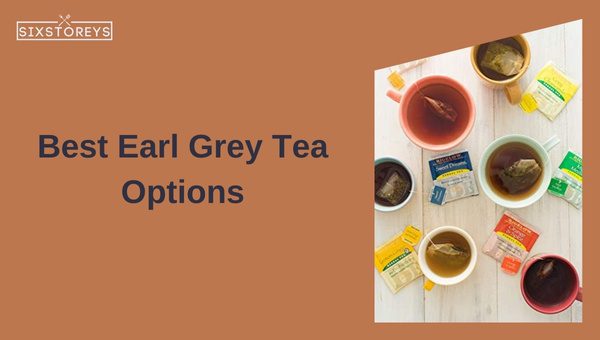
When it comes to the best Earl Grey tea options, it all boils down to personal preference. However, there are some crowd-pleasers that have gained worldwide acclaim for their unique blends, rich flavor, and quality ingredients. So, let's explore some top contenders in the realm of Earl Grey teas.
1. Twinings Earl Grey
Twinings has been crafting teas for over 300 years and its Earl Grey blend is renowned globally. With its distinct aroma of bergamot and a subtle hint of lemon and lavender, Twinings Earl Grey offers a perfectly balanced and flavorful cup of tea.
2. Harney & Sons Earl Grey Supreme
Harney & Sons has put a luxurious twist on the classic Earl Grey blend by adding Silver Tips. Their Earl Grey Supreme delivers a robust yet refined flavor resulting from a blend of black teas, bergamot oil, and white teas with Silver Tips.
3. Stash Earl Grey
Stash is a well-loved name in the tea industry due to its responsibily sourced teas. Their Earl Grey blend offers a beautiful balance between a full-bodied black tea and a rich citrusy twist of bergamot.
4. Bigelow Earl Grey
Bigelow offers a smoky, brisk, and bold Earl Grey blend. Hand-picked from high-elevation gardens and infused with pure bergamot oil, Bigelow's Earl Grey tea delivers a richly satisfying and sophisticated cup.
Best Alternatives for the Caffeine Conscious: Earl Grey Tea Substitutes
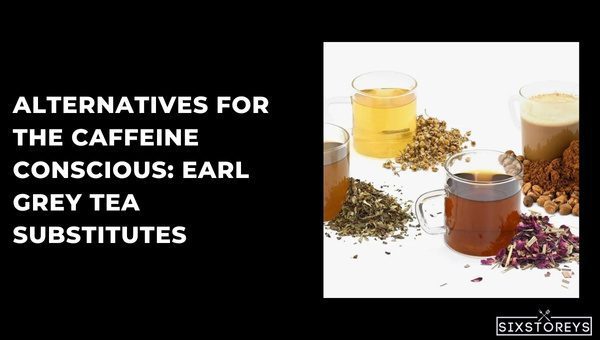
If you're sensitive to caffeine or are looking to minimize your caffeine intake, don't fret, there are caffeine-free Earl Grey substitutes available that maintain the rich, distinct flavor we all love.
Herbal Earl Grey
Herbal Earl Grey is made using a variety of caffeine-free herbs like rooibos or chamomile, while still incorporating a hint of bergamot flavor. Rooibos Earl Grey in particular offers a sweet and slightly nutty taste that’s well-complemented by the citrusy bergamot.
Decaffeinated Earl Grey
Most big tea brands offer decaffeinated Earl Grey. These teas undergo a process to remove the majority of the caffeine from the leaves while retaining the bulk of the flavor. Certainly, an option to look into for those wanting to keep their caffeine intake in check.
Green Earl Grey
Although not entirely caffeine-free, green Earl Grey contains significantly less caffeine than the traditional black tea base. It still carries the distinctive bergamot taste, on a lighter, slightly grassy tea base.
Fruit-Based Earl Grey
Some blends swap out tea completely, opting for fruit pieces and peels, like oranges, lemons, and hibiscus, to create a captivating, caffeine-free infusion that's rich in vitamin C and has a tartness that complements the bergamot.
Understanding the Earl Grey Tea Grading System
The quality of Earl Grey, like all teas, can be evaluated based on a grading system. This system primarily indicates the size and condition of the leaves, which plays a significant role in the flavor profile of your tea.
Whole Leaf Grades
Whole leaf grades retain the entire leaf and often deliver a rich and complex flavor. They’re found in premium and specialty teas. Some common whole leaf grades are Flowery Orange Pekoe (FOP), Orange Pekoe (OP), and Pekoe (P).
Broken Leaf Grades
Broken leaf grades, as the name implies, consist of smaller, broken tea leaves. They tend to have a stronger, bolder flavor. Broken Orange Pekoe (BOP) is a common broken leaf grade.
Fannings and Dust
Fannings and dust are the smallest grades of tea and are commonly used in tea bags due to their quick brewing time. However, they tend to lack the complex flavors of larger leaf grades.
Special Terminology
In addition to these basic grades, you might also see terms like "Flowery" or "Golden". These indicate special qualities or parts of the leaf that affect the flavor, with "Flowery" referring to the inclusion of young tea buds, while "Golden" suggests that the tea leaves contain golden tips.
Without a doubt, the world of Earl Grey tea is vast and fascinating, full of delightful blends, thoughtful alternatives, and nuanced grading systems. Whether you are a casual tea drinker or a discerning connoisseur, there’s plenty to explore and savor.
Getting Creative with Earl Grey: Unique Recipes to Try At Home

Have you tried incorporating Earl Grey into your dishes? No? Well, you're in for a treat! Earl Grey's unique flavor brings a whole new dimension to many dishes.
Earl Grey Infused Shortbread Cookies
This is a classic fusion of sweet delight and tea-time charm. Simply replace vanilla extract with Earl Grey tea in your preferred shortbread recipe.
Ingredients
- 2 Cups All-Purpose Flour
- 1/4 Teaspoon Salt
- 2 Teaspoons Loose Leaf Earl Grey Tea
- 1 Cup Unsalted Butter
- 1/2 Cup Powdered Sugar
Mix the tea leaves into the dough and bake as usual. The result? A scrumptious Earl Grey-infused sweet treat.
Earl Grey Hot Chocolate
Add a twist to your hot chocolate by steeping Earl Grey in the milk for a couple of minutes before adding your cocoa and sugar. This gives a delicate, citrusy undertone to your rich cocoa drink.
With your DIY Earl Grey blend to your innovative Earl Grey recipes, you're embracing this splendid tea to the fullest. Experiment, enjoy, and elevate your Earl Grey experience. From your favorite cuppa to a culinary delight - the possibilities really are endless with Earl Grey.
Also Read: What Are Steamers Seafood?
Frequently Asked Questions
What kind of tea is Earl Grey?
Earl Grey is a type of black tea that's flavored with oil from the rind of bergamot orange, a citrus fruit. It has a distinctive citrusy flavor and aroma, making it a favorite among tea lovers.
Where does Earl Grey tea originate from?
Earl Grey tea is named after Charles Grey, the 2nd Earl Grey, who was Prime Minister of the United Kingdom in the 19th century. It's said the unique blend was gifted to him as a diplomatic gift and later became a commercial success.
What are the main ingredients of Earl Grey tea?
The primary ingredients of Earl Grey tea are black tea leaves and bergamot oil. However, variations of the blend may include additional flavors such as lavender or other citrus peels.
Does Earl Grey tea contain caffeine?
Yes, being a black tea, Earl Grey does contain caffeine. The exact amount varies, but it's typically less than half of what you'd find in an average cup of coffee.
Are there any health benefits of Earl Grey tea?
Absolutely! Aside from being hydrating, Earl Grey tea is loaded with antioxidants. It might help improve digestion, fight off colds, and even boost your mood thanks to the bergamot oil.
Can I make a caffeine-free version of Earl Grey tea?
Yes, you can enjoy a caffeine-free version of Earl Grey by opting for blends that use decaffeinated black tea or herbal tea bases like rooibos.
What does Earl Grey tea taste like?
Earl Grey tea has a distinctive citrusy flavor thanks to the addition of bergamot oil. It also has the robustness of black tea with a slightly floral note, giving it a complex yet balanced taste profile.
What are some good alternatives to Earl Grey tea for those who don't like caffeine?
If you're sensitive to caffeine but love the flavor of Earl Grey, consider trying a caffeine-free rooibos blend or a herbal blend with similar citrusy notes.
Conclusion
In conclusion, it's clear that Earl Grey tea truly is a fascinating brew. From its deep roots in history to its distinctive flavor profile, there’s so much more to this tea than meets the taste buds. The caffeine content – around 45-50mg per cup – gives Earl Grey that stimulating effect, but it's important not to ignore the potential side effects of consuming too much caffeine. As with all good things in life, moderation is the key. This tea provides a host of health benefits and adds a lot of versatility to your kitchen with numerous Earl Grey-infused recipes.
So go on, brew yourself a cup, let the aroma fill your senses, and enjoy Earl Grey in its full glory. Don’t forget its caffeine content, however, to ensure you're not overdoing it. Furthermore, always explore the endless options out there - who knows, you might even find your new favorite brew.
